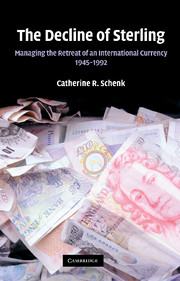Book contents
- Frontmatter
- Contents
- List of figures
- List of tables
- Acknowledgements
- 1 Introduction
- Part I Reconstructing the International Monetary System 1945–1959
- 2 The post-war international monetary system 1945–1950
- 3 The return to convertibility 1950–1959
- Part II Accelerating the Retreat: Sterling in the 1960s
- Part III Sterling's Final Retreat 1970–1992
- Index
3 - The return to convertibility 1950–1959
Published online by Cambridge University Press: 04 May 2010
- Frontmatter
- Contents
- List of figures
- List of tables
- Acknowledgements
- 1 Introduction
- Part I Reconstructing the International Monetary System 1945–1959
- 2 The post-war international monetary system 1945–1950
- 3 The return to convertibility 1950–1959
- Part II Accelerating the Retreat: Sterling in the 1960s
- Part III Sterling's Final Retreat 1970–1992
- Index
Summary
The turbulent international monetary relations of the late 1940s established the discourse of the burden of the sterling balances and the ‘overhang’, which persisted in characterisations of sterling's international role throughout the 1950s. Despite the continuity in how sterling's international status was interpreted, during the 1950s the actual role of sterling changed dramatically, as the wartime accumulations were exhausted and replaced by the official reserves of Commonwealth and colonial territories. During this decade the relatively weak performance of the British economy and the identification of ‘stop-go’ in the domestic policy cycle intensified public controversy over the constraint imposed on British policy-making by sterling's international role. The United Kingdom seemed to some commentators to be pursuing an ambitious global strategic and economic role that was detrimental to the national economic interest. This debate was both a prism for a reassessment of what Britain's global position should be, both economically and politically, and marked the beginning of the ‘declinist’ approach to assessing the performance of the British economy. After a bold scheme for the United Kingdom to lead an attack on the flawed Bretton Woods system was abandoned in early 1952, British governments learned that the management of sterling as an international currency was constrained by American and European attitudes.
- Type
- Chapter
- Information
- The Decline of SterlingManaging the Retreat of an International Currency, 1945–1992, pp. 83 - 116Publisher: Cambridge University PressPrint publication year: 2010



